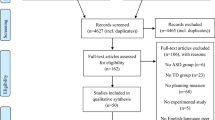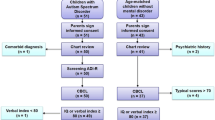Abstract
To learn to deal with the unexpected is essential to adaptation to a social, therefore often unpredictable environment. Fourteen adults with autism spectrum disorders (ASD) and 15 controls underwent a decision-making task aimed at investigating the influence of either a social or a non-social environment, and its interaction with either a stable (with constant probabilities) or an unstable (with changing probabilities) context on their performance. Participants with ASD presented with difficulties in accessing underlying statistical rules in an unstable context, a deficit especially enhanced in the social environment. These results point out that the difficulties people with ASD encounter in their social life might be caused by impaired social cues processing and by the unpredictability associated with the social world.





Similar content being viewed by others

References
Agam, Y., Joseph, R. M., Barton, J. J. S., & Manoach, D. S. (2010). Reduced cognitive control of response inhibition by the anterior cingulate cortex in autism spectrum disorders. Neuroimage, 52(1), 336–347. doi:10.1016/j.neuroimage.2010.04.010.
Allman, J. M., Watson, K. K., Tetreault, N. A., & Hakeem, A. Y. (2005). Intuition and autism: A possible role for Von Economo neurons. Trends in Cognitive Sciences, 9(8), 367–373. doi:10.1016/j.tics.2005.06.008.
American Psychiatric Association. (2000). Diagnostic and statistical manual of mental disorders, Fourth Edition, Text Revision (DSM-IV-TR). Arlington, VA: American Psychiatric Association.
American Psychiatric Association. (2013). Diagnostic and statistical manual of mental disorders, Fifth Edition (DSM-V). Arlington, VA: American Psychiatric Association.
Ames, C. S., & Jarrold, C. (2007). The problem with using eye-gaze to infer desire: A deficit of cue inference in children with autism spectrum disorder? Journal of Autism and Developmental Disorders, 37(9), 1761–1775. doi:10.1007/s10803-006-0309-5.
Baron-Cohen, S. (2002). The extreme male brain theory of autism. Trends in Cognitive Sciences, 6(6), 248–254.
Baron-Cohen, S. (2006). The hyper-systemizing, assortative mating theory of autism. Progress in Neuro-Psychopharmacology and Biological Psychiatry, 30(5), 865–872.
Baron-Cohen, S., Ring, H., Moriarty, J., Schmitz, B., Costa, D., & Ell, P. (1994). Recognition of mental state terms. Clinical findings in children with autism and a functional neuroimaging study of normal adults. The British Journal of Psychiatry: The Journal of Mental Science, 165(5), 640–649.
Baron-Cohen, S., Wheelwright, S., Skinner, R., Martin, J., & Clubley, E. (2001). The autism-spectrum quotient (AQ): Evidence from Asperger syndrome/high-functioning autism, males and females, scientists and mathematicians. Journal of Autism and Developmental Disorders, 31(1), 5–17.
Behrens, T. E. J., Hunt, L. T., Woolrich, M. W., & Rushworth, M. F. S. (2008). Associative learning of social value. Nature, 456(7219), 245–249. doi:10.1038/nature07538.
Behrens, T. E. J., Woolrich, M. W., Walton, M. E., & Rushworth, M. F. S. (2007). Learning the value of information in an uncertain world. Nature Neuroscience, 10(9), 1214–1221.
Blackerby, R. F. (1993). Application of chaos theory to psychological models. Thesis (Ph.d.) University of Texas, Austin, 1993, 1285.
Chiang, H. M., Tsai, L. Y., Cheung, Y. K., Brown, A., & Li, H. (2014). A meta-analysis of differences in IQ profiles between individuals with Asperger’s disorder and high-functioning autism. Journal of Autism and Developmental Disorders, 44(7), 1577–1596. doi:10.1007/s10803-013-2025-2.
Chiu, P. H., Kayali, M. A., Kishida, K. T., Tomlin, D., Klinger, L. G., Klinger, M. R., & Montague, P. R. (2008). Self responses along cingulate cortex reveal quantitative neural phenotype for high-functioning autism. Neuron, 57(3), 463–473. doi:10.1016/j.neuron.2007.12.020.
Couteur, A. L., Rutter, M., Lord, C., Rios, P., Robertson, S., Holdgrafer, M., & McLennan, J. (1989). Autism diagnostic interview: A standardized investigator-based instrument. Journal of Autism and Developmental Disorders, 19(3), 363–387. doi:10.1007/BF02212936.
Dawson, G., Meltzoff, A. N., Osterling, J., Rinaldi, J., & Brown, E. (1998). Children with autism fail to orient to naturally occurring social stimuli. Journal of Autism and Developmental Disorders, 28(6), 479–485.
De Martino, B., Harrison, N. A., Knafo, S., Bird, G., & Dolan, R. J. (2008). Explaining enhanced logical consistency during decision making in autism. The Journal of Neuroscience, 28(42), 10746–10750. doi:10.1523/JNEUROSCI.2895-08.2008.
Dichter, G. S., Felder, J. N., & Bodfish, J. W. (2009). Autism is characterized by dorsal anterior cingulate hyperactivation during social target detection. Social Cognitive and Affective Neuroscience, 4(3), 215–226. doi:10.1093/scan/nsp017.
Ewing, L., Pellicano, E., & Rhodes, G. (2013). Atypical updating of face representations with experience in children with autism. Developmental Science, 16(1), 116–123. doi:10.1111/desc.12007.
Friston, K. J., Lawson, R., & Frith, C. D. (2013). On hyperpriors and hypopriors: Comment on Pellicano and Burr. Trends in Cognitive Sciences, 17(1), 1. doi:10.1016/j.tics.2012.11.003.
Frith, U. (1970). Studies in pattern detection in normal and autistic children. I. Immediate recall of auditory sequences. Journal of Abnormal Psychology, 76(3), 413–420.
Gomot, M., & Wicker, B. (2012). A challenging, unpredictable world for people with autism spectrum disorder. International Journal of Psychophysiology, 83(2), 240–247. doi:10.1016/j.ijpsycho.2011.09.017.
Greene, D. J., Colich, N., Iacoboni, M., Zaidel, E., Bookheimer, S. Y., & Dapretto, M. (2011). Atypical neural networks for social orienting in autism spectrum disorders. Neuroimage, 56(1), 354–362. doi:10.1016/j.neuroimage.2011.02.031.
Kanner, L. (1968). Autistic disturbances of affective contact. Acta Paedopsychiatrica, 35(4), 100–136.
Klin, A., Lin, D. J., Gorrindo, P., Ramsay, G., & Jones, W. (2009). Two-year-olds with autism orient to non-social contingencies rather than biological motion. Nature, 459(7244), 257–261. doi:10.1038/nature07868.
Leekam, S. R., López, B., & Moore, C. (2000). Attention and joint attention in preschool children with autism. Developmental Psychology, 36(2), 261–273.
Lombardo, M. V., Barnes, J. L., Wheelwright, S. J., & Baron-Cohen, S. (2007). Self-referential cognition and empathy in autism. PLoS One, 2(9), e883. doi:10.1371/journal.pone.0000883.
Lord, C., Rutter, M., Goode, S., Heemsbergen, J., Jordan, H., Mawhood, L., & Schopler, E. (1989). Autism diagnostic observation schedule: A standardized observation of communicative and social behavior. Journal of Autism and Developmental Disorders, 19(2), 185–212. doi:10.1007/BF02211841.
Luke, L., Clare, I. C. H., Ring, H., Redley, M., & Watson, P. (2012). Decision-making difficulties experienced by adults with autism spectrum conditions. Autism: The International Journal of Research and Practice, 16(6), 612–621. doi:10.1177/1362361311415876.
Ma, W. J., Beck, J. M., Latham, P. E., & Pouget, A. (2006). Bayesian inference with probabilistic population codes. Nature Neuroscience, 9(11), 1432–1438. doi:10.1038/nn1790.
Nagai, M., Bennett, P. J., Rutherford, M. D., Gaspar, C. M., Kumada, T., & Sekuler, A. B. (2013). Comparing face processing strategies between typically-developed observers and observers with autism using sub-sampled-pixels presentation in response classification technique. Vision Research, 79, 27–35. doi:10.1016/j.visres.2013.01.001.
Pellicano, E., & Burr, D. (2012). When the world becomes “too real”: A Bayesian explanation of autistic perception. Trends in Cognitive Sciences, 16(10), 504–510. doi:10.1016/j.tics.2012.08.009.
Pruett, J. R, Jr, LaMacchia, A., Hoertel, S., Squire, E., McVey, K., Todd, R. D., et al. (2011). Social and non-social cueing of visuospatial attention in autism and typical development. Journal of Autism and Developmental Disorders, 41(6), 715–731. doi:10.1007/s10803-010-1090-z.
Qian, N., & Lipkin, R. M. (2011). A learning-style theory for understanding Autistic behaviors. Frontiers in Human Neuroscience, 5(77). doi:10.3389/fnhum.2011.00077.
Rutherford, M. D., Baron-Cohen, S., & Wheelwright, S. (2002). Reading the mind in the voice: A study with normal adults and adults with Asperger syndrome and high functioning autism. Journal of Autism and Developmental Disorders, 32(3), 189–194.
Sasson, N., Tsuchiya, N., Hurley, R., Couture, S. M., Penn, D. L., Adolphs, R., & Piven, J. (2007). Orienting to social stimuli differentiates social cognitive impairment in autism and schizophrenia. Neuropsychologia, 45(11), 2580–2588. doi:10.1016/j.neuropsychologia.2007.03.009.
Schmider, E., Ziegler, M., Danay, E., Beyer, L., & Bühner, M. (2010). Is it really robust? Reinvestigating the robustness of ANOVA against violations of the normal distribution assumption. Methodology: European Journal of Research Methods for the Behavioral and Social Sciences, 6(4), 147–151. doi:10.1027/1614-2241/a000016.
Schwartz, D. (1963). Méthodes statistiques à l’usage des médecins et des biologistes (p. 67). France: Flammarion.
Thakkar, K. N., Polli, F. E., Joseph, R. M., Tuch, D. S., Hadjikhani, N., Barton, J. J. S., & Manoach, D. S. (2008). Response monitoring, repetitive behaviour and anterior cingulate abnormalities in autism spectrum disorders (ASD). Brain, 131(9), 2464–2478. doi:10.1093/brain/awn099.
Uljarevic, M., & Hamilton, A. (2012). Recognition of emotions in autism: A formal meta-analysis. Journal of Autism and Developmental Disorders, 43(7), 1517–1526. doi:10.1007/s10803-012-1695-5.
Volkmar, F. R., Paul, R., Klin, A., & Cohen, D. J. (2005). Handbook of autism and pervasive developmental disorders (3rd ed., Vol.1, p. 1283). NewYork: John Wiley & Sons.
Wilson, C. E., Happé, F., Wheelwright, S. J., Ecker, C., Lombardo, M. V., Johnston, P., et al. (2014). The neuropsychology of male adults with high-functioning autism or Asperger syndrome. Autism Research, 7(5), 1–14. doi:10.1002/aur.1394.
Acknowledgments
We would like to thank all of the participants for making this research possible. This study was supported by a Scientific Research Council grant from the Vinatier Hospital Center; the work was performed within the framework of the LABEX CORTEX (ANR-11-LABX-0042) of Université de Lyon, within the program “Investissements d’Avenir” (ANR-11-IDEX-0007) operated by the French National Research Agency (ANR).
Author information
Authors and Affiliations
Corresponding author
Rights and permissions
About this article
Cite this article
Robic, S., Sonié, S., Fonlupt, P. et al. Decision-Making in a Changing World: A Study in Autism Spectrum Disorders. J Autism Dev Disord 45, 1603–1613 (2015). https://doi.org/10.1007/s10803-014-2311-7
Published:
Issue Date:
DOI: https://doi.org/10.1007/s10803-014-2311-7



